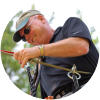I first noticed it about two or three weeks ago: The task of walking the dog each morning, which had been all but silent in December and January, was slowly being accompanied by a natural playlist.
Some of what I'm hearing is melodious, ending with a cheery "kik-kik-kik." Some has the shrill trill of a police whistle. Some is brash and percussive: "Baw! Baw! Baw!"
Paul Zeph is the Director of Conservation at Audubon Pa., which oversees the John James Audubon Center at Mill Grove. He confirms that morning music is on the upswing.
"The birds are starting to react to the lengthening days," he says. "Daylight beings to trigger the release of hormones, particularly in the males. That release of testosterone starts them singing. They're broadcasting a natural territoriality in advance of mating and nesting."
In other words, the tweets and twitters may sound merry, but they're really serious business. They're a claim to exclusivity. And a warning for potential challengers to back off.
Songbirds aren't the only feathered friends putting up audible "No Trespassing" signs. Zeph describes one of his own pre-dawn encounters: "This morning I heard a woodpecker starting to drum. Woodpeckers don't vocalize in song; instead, they make that machine gun-like tapping on a hollow part of a tree. That is their territorial sound. People think they're looking for bugs, but it's too early for bugs right now. No, that bap-bap-bap is a woodpecker broadcasting the message, ‘Hey, stay out! This is my territory.'"

The stunning Cardinal
Among the early seasonal singers are cardinals, song sparrows and the tufted titmouse. Robins, which most people identify as a solid sign of springtime's warmth, aren't due for another handful of weeks. "In summers, robins eat bugs, and in winter, they're berry eaters," Zeph says. "So robins right now are moving from tree to tree and cleaning up what's left. It won't be until the local eruption of bugs in late April and early May that you'll see large populations of robins."
A changeover is definitely in motion, according to Zeph. Migration patterns mark the exit of certain species - juncos and white-throated sparrows - and the return of others. Among tenants moving back into our neighborhoods are the turkey vultures, who traveled southward when our temperatures plummeted last November. As with the robins, food is the driver: "They go where the road kill isn't frozen solid," Zeph laughs.
The sight of geese flying in a streamlined V across the sky is a picturesque scene in places like Green Lane Park or Fort Washington State Park, but Zeph says only certain geese populations are on the move this time of year. "There are resident geese and there are migratory geese," he distinguishes. Migratory geese nest around the Chesapeake to our south and return in late March. Resident geese weather the winter staying put, provided food sources remain steady.

The Tufted Titmouse
The calendar may put the vernal equinox a little more than two weeks away, but Zeph says that Mother Nature is already in full springtime mode. "In the animal world and in nature," he philosophizes, "seasons don't have these distinct periods of time. It's a continuum that slowly flows from one to the other. As days lengthen, each day the productivity of songbirds and their associated singing will increase and increase. In early May, you'll hear that cacophony in the morning of bird song. It will be almost deafening. And it will start at 4:30 a.m."
Who needs an alarm clock?
The John James Audubon Center at Mill Grove is a terrific resource on bird behavior and the science of migration, mating, nesting and singing. It's also a picturesque place to bird watch; the views over the Perkiomen Creek are stunning year-round.

If the rat-a-tat of a woodpecker evokes the sound of musket fire from the pages of history, you might enjoy the guided bird walks at Valley Forge National Historical Park. On the second and fourth Tuesdays of each month from March to October, local bird experts Mary Ellen and Tom Heisey point out the sights and sounds of our fine-feathered friends as they brighten up the meadows and trees. More information is available from the Friends of Valley Forge.
All this talk of nesting may inspire you to grab your brood and spend a weekend in one of our fine hotels and inns in Valley Forge and Montgomery County. The price breaks and discounts available through our Cabin Fever Reliever promotion can lower the price of a getaway to something that could definitely qualify as being "cheep."






